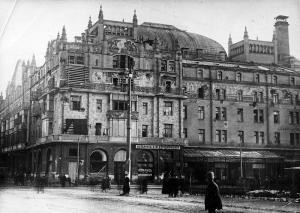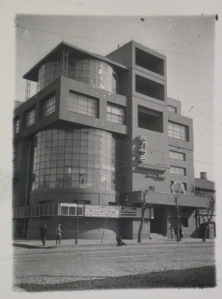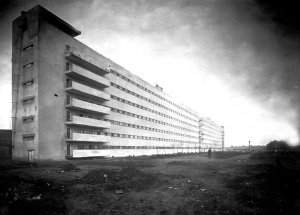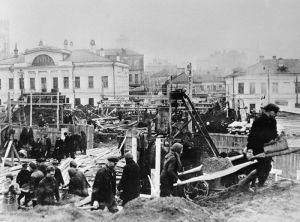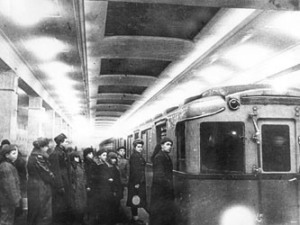Revolution and Modernisation in Moscow
Tomas Creagh Student No: 112406628
(Fig 1: Damaged buildings during the Revolution of 1917)
The centre of the October Revolution of 1917 was centred mainly in St Petersburg however also experienced a large scale Bolshevik uprising which experienced bitter street battles lasting from around the “29th of October to November the 11th” 1. Evidence of the damage these battles caused in Moscow can be seen in the image above. Moscow would remain under Bolshevik control following the uprising and throughout the Civil War. The Bolshevik Revolution brought about massive changes to Moscow as a city and saw a drive for modernisation and better living quality for its inhabitants.
(Fig 2: Zuev Workers Club Moscow Built in 1928)
Following the Revolution and Civil War the new Soviet government sought to modernise its cities in order to show the world the strengths of Socialism. One of the ways in which they showcased this was through the medium of Modernist architecture which would become a common sight throughout cities in the USSR including Moscow. Figure: 2 is an early example of Modernist architecture in the form of a workers club which is a political statement as well as a showcase for modernisation in Moscow.
(The Communal House of the Textile Institute Moscow 1929)
“By abolishing private property in land and building cheap and hygienic dwellings can the housing problem be solved” 2. This quote by Lenin shows how the Soviet Government aimed to construct housing which would be beneficial to the health, hygiene and well being of its inhabitants. Due to the large number of people in need of proper housing the idea of the Kommunalka or communal apartment was born. These apartments vastly improved the quality of life for many of Moscow’s residents as they came with electricity and indoor plumbing and even though they were overcrowded they were still a large improvement on the unhygienic slums they replaced.
(Fig: 4 Construction Of Moscow Metro)
Mobility became an issue for the quickly industrialising Moscow during the Stalinist era. To combat this issue large public transport initiatives were carried out. The most famous of these initiatives being the Moscow metro which saw its first line completed in 1935. Above we can see workers building the metro. This Metro line also showcased the modernity of Moscow as well as providing its citizens with increased mobility.
(Fig: 5 Muscovites making use of new Metro 1935)
Fig: 1 http://englishrussia.com/2013/02/13/moscow-destroyed-by-the-revolution/
Fig: 2 http://thecharnelhouse.org/2014/06/01/soviets-workers-clubs-in-the-1920s/
Fig: 3 http://thecharnelhouse.org/tag/communal-house-of-the-textile-institute/
Fig: 4 http://rbth.com/articles/2011/02/23/the_12_most_english_places_in_moscow_12486.html
Fig: 5 https://welcome2russia.wordpress.com/2013/08/26/exploring-moscow-metro/
References:
- Moscow Destroyed By The Revolution. (2013, February 13). Retrieved from http://englishrussia.com/: http://englishrussia.com/2013/02/13/moscow-destroyed-by-the-revolution/
- Lenin, V. (n.d.). Materials Relating to the Revision of the Party Programme. Retrieved from http://www.marxists.org: https://www.marxists.org/archive/lenin/works/1917/reviprog/ch04.htm
